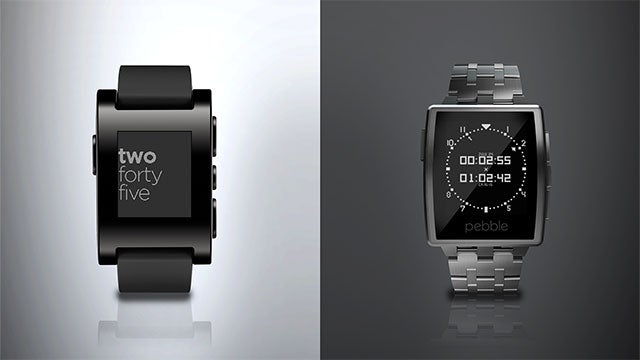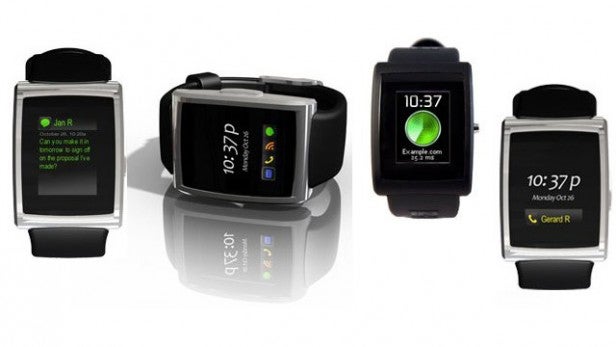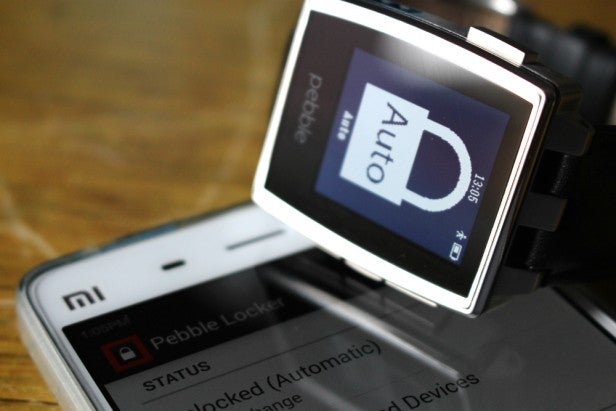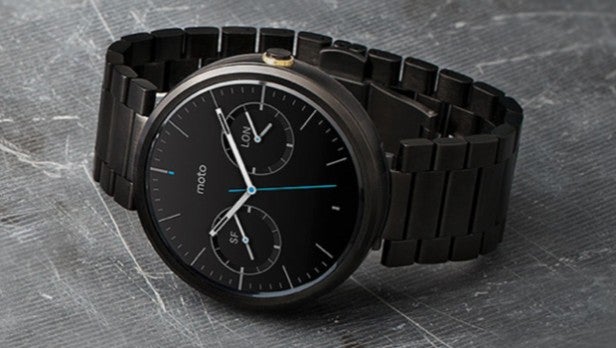TR Talks: Pebble on the Apple Watch, Android Wear and more

Pebble Chief Evangelist Myriam Joire talks about all things smartwatches including that ‘one’ from Apple…
2014 was supposed to be the year of the smartwatch and while the likes of Samsung, Motorola and Google did their very best to sell us these ‘smartphone companions’, they didn’t really succeed.
There is one smartwatch-maker that remains largely untouched by the majority of crticism we’ve reserved for the Moto 360, the Samsung Gear S and to a slightly lesser extent the LG Watch G R.
Since raising bucketloads of dollars through crowdfunding site Kickstarter, Pebble has barely put a foot wrong. The original Pebble and Pebble Steel remain the most compelling examples of what a smartwatch should be, whether that’s delivering an acceptable amount of battery life, cross-platform support or an ecosystem that makes changes based on what users really want.
2015 promises to be a challenging year for Pebble and the rest with the arrival of the Apple Watch. A smartwatch that could really change everything, or possibly change nothing at all.
Grabbing some time recently with Pebble’s Chief Evangelist Myriam Joire at Glazedcon, a conference looking at the present and future state of wearables, we touched on the subject of Apple’s entry into the world of smartwatches. We also spoke about that Kickstarter success, sizing up the competition and what’s next for a company whose CEO never owned a watch before setting up a smartwatch company.
Here’s a pick of the best bits from our insightful chat.
The birth of Pebble
“It’s delightful to have a good dream instead of a nightmare. It’s probably a better question to ask Eric Migicovsky the CEO, it’s his baby, but I know the story well. He was a student and he was doing a semester in the Netherlands. He was riding his bicycle and had the iPhone, which had just come out and he was always worried about dropping his iPhone while he was riding his bike. So he was like, I need to get a bike computer on my handlebar that shows me my notifications. Why not just put it on my wrist? And here we are. Eric is very pleased we we are at at the moment.”
SEE ALSO: Apple Watch vs Pebble

InPulse, the pre-Pebble
“Eric and his team were friends when they were at university in Canada and when he decided to come up with this project, he came up with the idea of doing a smartwatch that could receive notifications and they refined it into a first product that wasn’t really successful.
It was kind of like the prototype Pebble. It was called InPulse (pictured above). InPulse was a watch that wasn’t waterproof and had a one-day battery life, a colour LED display with one button so there was no touchscreen. It ran a much simpler version of a RAM processor as well. It could only run one app at the time.
The idea that Eric got right from the beginning is that developers should be able to write an app on their own and augment what the InPulse team were doing.
When Eric started with InPulse, they were based at Waterloo in Canada at the HQ of BlackBerry, so they got a bit of money from them and optimized it for BlackBerry. Then they added Android support. At the time there was no way to add iOS Bluetooth support because Apple didn’t support that until iOS 5.
So they played with that to see what worked and didn’t work and what they learned very quickly is that notifications was killer. Just being able to glance and go, oh, I have an email from someone. What they also learned is that one-day battery life is terrible. It meant one more device to manage. The other thing they learned was that the screen was not readable. It was a big problem. OLED display technology has improved significantly since those days though. Not being waterproof became a hurdle.
With Pebble they took the concept of the watch and pulled it into the 21st century. Rather than shrink the smartphone and put it around your wrist, their premise was, if we want to be successful, we need to be able to at least take what people are familiar with and apply that to today’s devices.”
The key to Pebble’s wrist appeal
“We have four pillars that’s key to our success. Good battery life, a waterproof design, an always-on readable display and cross platform support.
When Eric moved on from InPulse and did Pebble, one of the big changes when it launched on Kickstarter was to really get people excited about support for Android and iOS from day one. Then we could add more operating systems if we want to, but at least get the big ones out the door. We don’t see that changing at all.
Some could argue we could maybe take the approach of shrinking the smartphone to the wrist is the way to go, but I don’t think that’s viable and it’s been proven by the market. The user experience is not as delightful in our competitor’s products. That’s what we hear from our customers.”

The Pebble smartwatch app philosophy
“Apps are not meant to replace what your phone does, it’s about the immediacy. There’s a different bunch of things they can do. Like acting as a remote control for music playback or controlling a Go Pro. Then there’s the fitness angle. We have companies like Jawbone and Misfit on board. This is very much part of the Pebble philosophy. We don’t know how to do step tracking well, so why don’t we partner with experts?
We are not going to force people into a Pebble health ecosystem, when Jawbone and Misfit do it so well. These companies like that idea because making so-called ‘dumb’ smartbands is kind of a financially losing proposition right now. They are going to be undercut by these Chinese unknown brands that won’t interface with their ecosystem.
When people ask if we were integrate with HealthKit, we don’t, but Jawbone does so we can become a bridge to HealthKit. It’s all about creating an open platform where you can plug it into it at different levels.”
Apple Watch and Android Wear: The good and the bad
“I think Android Wear’s voice control is the way to go. I can’t speak out on our future products but our customers will be very excited about what we are going to launch in 2015. Voice is a great way to interface with your device in some circumstances, like quickly answering a text message for instance. Android Wear is doing the voice thing really well. The fact that notifications are rich notifications that are now actionable are cool. We are supporting that in iOS 8.
I see the Apple Watch very much in the same way as Android Wear. Trying to shrink that smartphone experience to a watch but with all the great things Apple can do like a beautiful user experience, beautifully refined manufacturing materials and the price to match. I don’t think they are adding too much to the equation really. They are just doing it the Apple way.
What our rivals are doing wrong is battery life, problems with displays and the fact they are not always easy to read in daylight. They are always have to be off unless you really want to waste your battery.

They are getting these things wrong because the hardware simply doesn’t exist. You have a choice. You either do it the Pebble way with a customizable operating system, with a very low power ARM chip and low-power display or you go all out and try to shrink the smartphone down to your wrist. Both are valid in their own way but at the same time, we feel like the user experience is better the way we are doing things.
It’s the same with displays. At the moment you have to make a choice. A smart, intelligent company would do a smartwatch with a choice of displays so the user can choose whether they want to give up some battery life or go for something with a display that will give you much better battery life.”
Pebble not concerned by possibility of Apple cutting them out of the App Store
“I think the US FTC would find that very anti-competitive if they did. Let’s just put it that way. We are not a company that’s wants to get into legal wrangling. We believe in the DIY, hacker nerd way of thinking and doing things as openly as possible. We are interested in collaborating with Apple. They have not shown any threats in our direction. They have actually continued collaborating with us and letting us add functionality to our app store. They don’t see it as a threat.
If they do ostracise us from the App Store, we have a bunch of things we can do so we can provide our users with apps without having to go through Apple. It would cause friction for sure but we just hope it won’t come to that and we don’t think it will.”
Pebble on Windows Phone. Not impossible, but not yet
“We really want to be able to work other ecosystems. We’d love to add Windows Phone 8.1 but it’s not practical in terms of the manpower, resources, and money. The market isn’t big enough for us to spend on an entire engineering team to focus on this because we wouldn’t want to do it half assed. We’d want to do a good job of it.
Now that Windows Phone GDR 1 is available all the APIs are in place so a third party developer could make a Pebble companion app that would work seamlessly with Pebble and provide the same functionality as the official Pebble app on iOS and Android. We are not going there yet. We might go there in the future.”

Pebble round not around the corner
“In an ideal world, we would love to make a square or a round, thin and light watch. We just don’t have the resources. Maybe we could partner with up with a brand like Nixon to make something like that happen but that’s not something we really have plans to do. We could, but at the moment we only have time to do a small amount of products at a time.”
Bye bye Pebble Steel custom bands
“The Pebble Steel was designed to have a custom band attachment, which we think, we might revert back to what we did with the original Pebble and go with a standard band. The Steel’s band is good, but it looks great because the design we have. It requires third parties to create custom bands for Pebble.”


